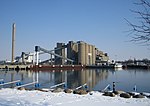Øresund Bridge

The Øresund or Öresund Bridge is a combined railway and motorway bridge across the Øresund strait between Denmark and Sweden. It is the second longest bridge in Europe with both roadway and railway combined in a single structure, running nearly 8 kilometres (5 miles) from the Swedish coast to the artificial island Peberholm in the middle of the strait. The crossing is completed by the 4-kilometre (2.5 mi) Drogden Tunnel from Peberholm to the Danish island of Amager. The bridge connects the road and rail networks of the Scandinavian Peninsula with those of Central and Western Europe. A data cable also makes the bridge the backbone of Internet data transmission between central Europe and Sweden. The international European route E20 crosses via road, the Øresund Line via railway. The construction of the Great Belt Fixed Link (1988–1998), connecting Zealand to Funen and thence to the Jutland Peninsula, and the Øresund Bridge have connected Central and Western Europe to Sweden by road and rail. The bridge was designed by Jørgen Nissen and Klaus Falbe Hansen from Ove Arup and Partners, and Niels Gimsing and Georg Rotne.The justification for the additional expenditure and complexity related to digging a tunnel for part of the way, rather than raising that section of the bridge, was to avoid interfering with air traffic from the nearby Copenhagen Airport, to provide a clear channel for ships in good weather or bad, and to prevent ice floes from blocking the strait. Construction began in 1995, with the bridge opening to traffic on 1 July 2000. The bridge received the 2002 IABSE Outstanding Structure Award.
Excerpt from the Wikipedia article Øresund Bridge (License: CC BY-SA 3.0, Authors, Images).Øresund Bridge
E 20, Malmö kommun
Geographical coordinates (GPS) Address External links Nearby Places Show on map
Geographical coordinates (GPS)
| Latitude | Longitude |
|---|---|
| N 55.57 ° | E 12.85 ° |
Address
Øresundsbron
E 20
Malmö kommun
Sweden
Open on Google Maps










